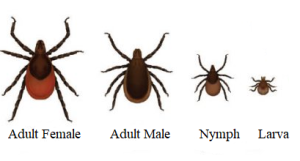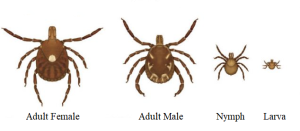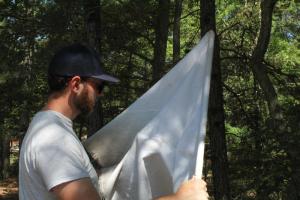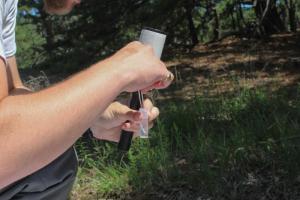Land-use changes, mild winters cause rise in tick population
Due to the change in climate and rising development in the area, Delaware has experienced a rise in its tick population.
As more people have interactions with these almost-unnoticeable creatures, officials say it is crucial to understand the threat they hold and how to prevent tick exposure.
As small as they are, ticks can carry harmful and even deadly diseases, the most common being Lyme disease. Over the past few years, Delaware has recorded high numbers of Lyme disease cases.
Delaware hit peak numbers in 2019, with 659 in-state cases of Lyme. Following the peak, Delaware had 353 cases in 2020, 354 cases in 2021 and 385 cases in 2022, according to reports from the Delaware Department of Natural Resources and Environmental Control.
Additionally, 98% of Delaware’s tick population is made up of lone star ticks, which was not apparent 10 years ago, said Dr. Ashley Kennedy, a tick biologist with the Division of Fish and Wildlife.
The spike in the tick population is due to two environmental factors – land-use changes and climate change.
This past year and years prior, Delaware has experienced incredibly mild winters, she said. Freezing temperatures keep the tick population in check, but since cold winters have been scarce, tick populations have continued to grow.
Ticks thrive in edge habitats, areas where two different habitats meet. As Delaware has seen urban growth explode over the past few years, ticks have inhabited areas where forests and grasslands meet, often backyards. As a result, ticks are inching closer to residents’ everyday lives.
To keep safe and healthy, it is important to know what ticks and diseases to look out for.
Delaware is home to five species of ticks, including the lone star tick, the black-legged/deer tick, the American dog tick, the Gulf Coast tick and the Asian longhorn tick.
The most common of the five and the two that pose the greatest threat to humans are the black-legged tick and the lone star tick. These species can carry diseases that can completely change a person’s way of life if infected.
The black-legged tick, most commonly known as the deer tick, is a species that commonly carries Lyme disease. If not treated, Lyme disease can leave its subject with severe arthritis and nerve pain, as well as other negative long-term effects.
Experts say 80% of people infected with Lyme disease develop a bullseye rash within the first phase of the disease. Other symptoms include fatigue and other flu-like symptoms such as headaches, joint and muscle aches, and loss of appetite. One in five people also develops a fever, said Dr. Bill Chasanov, an infectious disease physician with Beebe Healthcare.
Lone star ticks carry a disease called Alpha-gal, otherwise known as red meat disease. Post-infection, carriers of this disease can no longer eat red meat and some other animal by-products. If consumed, subjects are prone to anaphylactic shock.
Because of the severity of these tick diseases, it is crucial to know how to prevent tick exposure and how to properly react to tick interaction in the event of exposure.
Prevention methods are limited, as not enough is known about ticks to prevent exposure on a mass scale. Delaware did not develop the Division of Fish and Wildlife tick program until 2019. Since then, research has been done on ways to prevent tick exposure individually.
Sprays and other extermination methods are not suggested, as sprays tend to kill or harm other wildlife. Additionally, not enough is known about the way ticks live and what they can withstand to properly contain or eliminate unwanted populations.
Nonetheless, there are ways to help keep ticks off individual properties through landscaping services.
A recommendation by the Division of Fish and Wildlife tick program is to get rid of Japanese barberry, Japanese stock grass and other brush in the yard. Contrary to popular belief, ticks tend to hide in these short, grassy plants, not high up in trees. They are attracted to these plants specifically, so clearing these plants will help limit tick exposure.
The Division of Public Health adopted the acronym BLAST to help people remember what to do for tick prevention. According to infectious disease epidemiologist Jamie Ahlers, BLAST stands for: B – bathe after going outside, as the water pressure will help remove potential ticks; L – look for ticks; A – apply repellent on one's body and clothes; S – safeguard your yard; and T – treat your pet.
Other prevention methods include wearing long sleeves and pants, tucking in clothes and staying inside if possible. Repellents that contain DEET are highly recommended when going into outdoor/wooded areas.
In the event that a tick is found and is already attached, the best way to remove the tick is to do so gently with tweezers. The goal is not to disturb the tick, so that it does not transfer any diseases to the body during the removal process.
Ticks are naturally very small, especially the black-legged tick, so if a tick is enlarged upon discovery, it is likely it has been attached for a significant time. No matter the size of the tick, it is always recommended to see a medical provider post-tick bite.
It is also important to understand that not all ticks carry diseases. Only a percentage of ticks carry harmful diseases, and many species do not pose a threat to humans. Even so, it is good to protect yourself and seek medical care upon tick interaction.
For more information about Delaware ticks, tick prevention, Lyme disease and other helpful information, go to dnrec.alpha.delaware.gov/fish-wildlife/ticks/ or de.gov/lyme.



























































